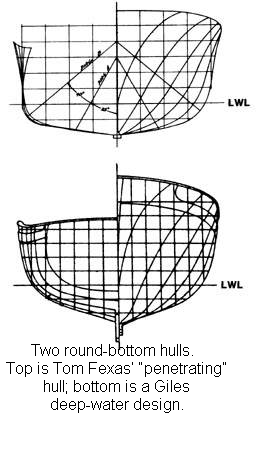Round-Bottom Hulls
(Second in a three-part survey on powerboat hull design. Reprinted from the April 1979 Motor Boating and Sailing.
When you think of round bottom boats you think of Elco, Matthews, Consolidated, Trumpy. Remembering those old boats is like seeing Gone With the Wind for the 15th time, or taking a detour past your old school to see if that girl you used to know is still waiting after eighth period.
But the designers of the old boats, most dead and gone these many years, have enjoyed a resurgence lately. Not out of nostalgia, but for good reason.
 The round bottom makes a strong hull. Any engineer will tell you that a squared corner creates areas of stress. And a chine is just such an area. In fiberglass construction, this is of less importance than it Used to be, because insides of chines usually radiused with heavy glass buildup – a lesson learned from early fiberglass chine hulls where stress cracking was seen along the chines of boats that were abused. But on boats where both the inside and outside of the bilge angle are rounded, the energy is spread out and stress is never a problem. This type of chine treatment can be called the ‘soft chine’ approach. The boat’s sections retain the flatness of the chine form, but the edge sharpness is reduced drastically.
The round bottom makes a strong hull. Any engineer will tell you that a squared corner creates areas of stress. And a chine is just such an area. In fiberglass construction, this is of less importance than it Used to be, because insides of chines usually radiused with heavy glass buildup – a lesson learned from early fiberglass chine hulls where stress cracking was seen along the chines of boats that were abused. But on boats where both the inside and outside of the bilge angle are rounded, the energy is spread out and stress is never a problem. This type of chine treatment can be called the ‘soft chine’ approach. The boat’s sections retain the flatness of the chine form, but the edge sharpness is reduced drastically.
Another plus for reducing the hardness of the chine is the improved flow of water along the hull, at displacement speeds. Chines tend to drag somewhat until the hull has broken free on plane. After planing is achieved, however, chines are useful in carrying the flat sectional shape to the outboard limit of the hull, thereby keeping the fast water-flow even and unidirectional over the breadth of the bottom.
But for boats that are not designed to plane, the rounded form is superior in reducing turbulence at the bilge areas. This is not to say that the rounder you make the bottom, the better the displacement performance. Sections that are broad and flat aft still improve the buoyancy and flow characteristics in the stern regions more than after sections that are pinched and too deep. So, a compromise between the shallow flatness of the V-bottom and the smooth curvature of the old round-bottom type is what many designers of displacement cruisers are aiming for.
Form stability
It is well known that chines help dampen roll in certain conditions. But what if the chines have been drastically radiused? Important question, and it involves a two-part answer. A round bottom boat, given the same weight placement as its V-bottom counterpart, will tend to roll more in quartering or beam seas. A designer knows this, and tries to lower his weights to offset the stiffness sacrificed by rounding the sections. Midnight Lace, a rounded-chine express cruiser by Tom Fexas of Florida (“Return of the Rumrunner,” March 1978), has extremely lightweight construction topside in order to compensate for both her softened bilges and her narrowness.
Jack Hargrave, designer of Hatteras Yachts, takes another approach. He uses soft chines in the forward sections of his Long Range Cruisers to reduce turbulence in those areas, but squares the chines aft, hardening them for the form stability needed for offshore work. His approach is to try for the best of both the round-bottom and V-bottom.
Ride
Anyone who’s ever taken a round bottom vessel to sea will attest to the smoothness of the ride at speeds above the survival range. This is because most (older) round-bilged boats have the fine entries and convex forward sections necessary for slicing a head sea. However, a proper flare forward should be designed-in above the waterline to keep those fine sections from sub-marining. This flare increases the potential buoyancy above the waterline only.
The round-bottom hull has seen its heyday, but the principles learned from its application live on in the form of modifications to present planing forms as well as in larger displacement vessels where drag and fuel efficiency are major considerations. -Doug Schryver

